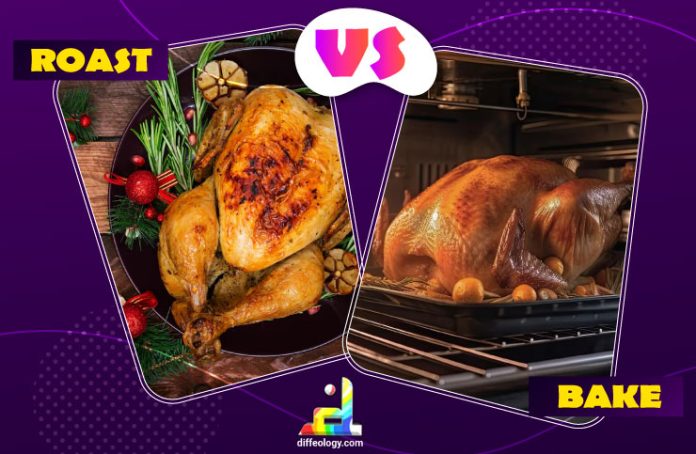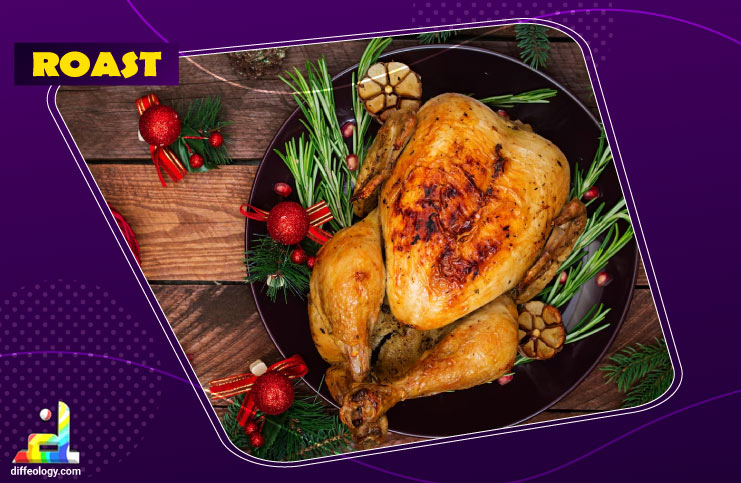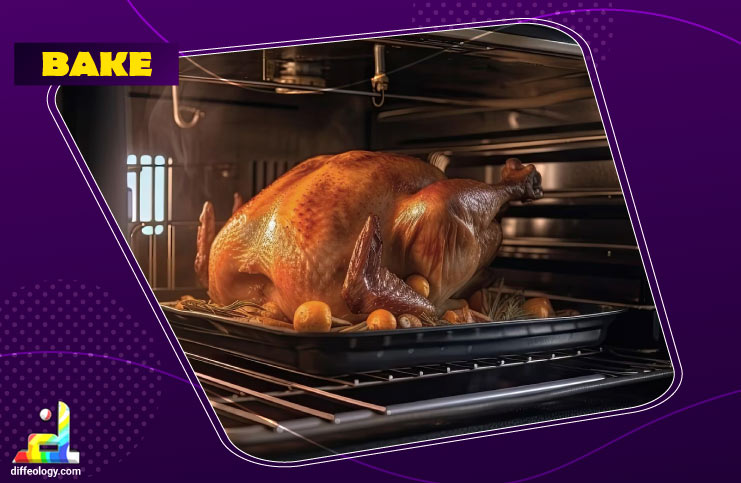Roasting and baking are types of dry-heat cooking in which hot, dry air is employed to bring about the cooking process. The two names are often used synonymously. The cooks, though, are quick to point out the Difference Between Roast and Bake.
Both of them refer to processes that often take place in an oven. Dry heat is used in each of these methods. Roasting was originally exclusively done over an open flame. However, the phrase is also used to describe ovens because most of them employ convection heating and cooling methods.
Main Difference Between Roast and Bake
When cooking food in a roasting oven, fat is often used. After being cooked, most foods maintain their original shapes. Food undergoes a noticeable transformation when baked. Foods made with flour are often baked, whereas meats are roasted.
Roast Vs. Bake
What is Roasting?
It is a cooking technique that’s all about transforming raw ingredients, like meat or vegetables, into tasty, flavorful dishes. It’s like magic in the kitchen! Imagine you have a big piece of meat, like a juicy chicken or a mouthwatering beef roast. When you roast it, you pop it into the oven at a high temperature, usually around 350°F to 450°F (175°C to 230°C), and let it cook slowly. This makes the outside of the meat get all crispy and golden brown while the inside stays tender and juicy. It’s like giving your food a special tan!
Read Also: Difference Between Baking And Broiling
When you roast vegetables, you take your favorite veggies, like carrots, potatoes, or even broccoli, and toss them with a little oil, salt, and some yummy spices. Then, you spread them out on a baking sheet and roast them in the oven until they get caramelized and delicious. So, roasting is like giving your food a cozy sunbath in the oven, making it taste fantastic and bringing out all the flavors.
What is Baking?
Baking is like a fun science experiment in the kitchen, and it’s all about making sweet treats and scrumptious bread! Imagine mixing together ingredients like flour, sugar, eggs, and maybe some chocolate chips to create cookie dough. When you bake, you put that dough into a hot oven, usually around 350°F to 375°F (175°C to 190°C), and watch the magic happen. It’s like turning gooey dough into delightful, edible treasures!
Read More: Difference Between Quinoa and Couscous
Baking can also transform a simple mixture of flour, water, yeast, and other ingredients into a fluffy cake or a loaf of bread. The yeast in bread dough, for example, makes tiny bubbles that puff up the dough as it bakes. This gives bread its soft and airy texture. Baking is like using your oven as a magic machine to turn ingredients into delightful goodies!
Baking is not just about making sweet treats; it’s a way to create all sorts of delicious foods. From cookies and cakes to bread and even savory dishes like casseroles and quiches, baking is a fundamental cooking technique that lets you explore your creativity in the kitchen.
Difference Between Roast and Bake in Detail
1. Temperature and Cooking Method:
Roasting typically involves cooking food at higher temperatures, usually above 300°F (150°C). It is a dry cooking method where heat surrounds the food, creating a crisp exterior and a juicy interior. People often use roasting for larger cuts of meat, such as whole chickens, turkeys, and roasts.
Baking, on the other hand, involves cooking food at lower temperatures, often between 300°F to 450°F (150°C to 230°C). People also use it as a dry cooking technique, but its main purpose is in the world of baking delicious treats like bread, cakes, cookies, and casseroles. Baking relies on indirect heat to cook food evenly.
The temperature ranges and the types of dishes they’re best for set them apart. People prefer roasting when they want meats and vegetables to have a crispy outside. On the other hand, they opt for baking when they need a gentle, even cooking process, especially for baked goods.
2. Cooking Vessels:
When you’re roasting, you often use shallow, open pans or special racks that let hot air move around the food. These pans can have short sides or be totally flat to help make your food brown nicely.
Now, when it comes to baking, you use deeper, covered containers like baking sheets, cake pans, or casserole dishes. You should have them hold your cake batter or dough and help it rise evenly while it’s baking.
So, picking the right cooking dish is super important. Roasting pans are all about making sure the heat gets all around the food. But baking dishes are available to keep things moist and make sure the heat spreads out evenly.
3. Types of Food:
So, when it comes to cooking, roasting is like the superhero for meat, chicken, and hearty veggies like potatoes, carrots, and Brussels sprouts. It uses high heat to make them taste amazing and gives them a nice, crispy texture.
On the other hand, baking is the champ for making things like bread, cakes, cookies, and casseroles. It uses lower heat and takes more time to make stuff rise and turn all golden and delicious.
The reason we use these methods for different foods is because they have their own special powers. Roasting makes meat and veggies taste awesome, while baking is all about making sure your baked goods turn out with the perfect texture and structure.
4. Cooking Process and Texture:
Roasting cooks things up pretty quickly and gives them a crispy, browned outside while keeping the inside all juicy and tasty, especially when it comes to meat. You know, like when you get that caramelized crust on a perfectly roasted steak?
Now, baking is a bit more patient. It takes its time to let dough and batter rise, and that’s how you end up with soft, fluffy bread or cakes with that yummy golden brown outside. Baking is all about making sure everything inside is nice and even.
So, in a nutshell, roasting gives you that mix of crispy on the outside and juicy on the inside, while baking is all about making everything tender and uniform.
5. Seasonings and Flavors:
When you’re roasting stuff, it’s all about adding herbs, spices, and special rubs that make meat and veggies taste even better. The high heat makes those flavors pop and fills the kitchen with that awesome roasted smell.
Now, when it comes to baking, it’s a bit of a sweet story. You’re tossing in things like sugar and vanilla for desserts or maybe herbs and cheese for savory dishes. Baking takes its time, so those flavors have a chance to mix and become super tasty.
So, roasting is about making natural flavors shine, while baking is all about adding extra ingredients to make your food taste amazing.
6. Cooking Outcome and Presentation:
When you roast stuff, it’s like bringing out the rugged and hearty side. Meats come out with this awesome crispy skin or crust, and it looks so good because of that nice browning and caramelization.
Now, baking is like a whole different art. Baked goodies are all about looking fancy and delicate. Think about cakes and pastries with icing, toppings, and cool decorations to make them super pretty.
Thus, roasting gives you that rugged, rustic charm, while baking is all about creating these intricate and eye-catching treats.
7. Cooking Times and Techniques:
Roasting is typically a quicker cooking method, with meats like chicken or beef roast requiring less time. People often use it for dishes that benefit from a shorter cooking duration.
Baking involves longer cooking times, especially for items like bread or cakes. The slow, even heating allows for the rising of the dough and the development of complex flavors.
They have differences in their cooking times and techniques. Roasting is a faster method that’s well-suited for meats, while baking takes its time to create beautifully risen baked goods.
8. Use of Fats and Oils:
Roasting often involves the use of fats and oils to help brown and crisp the exterior of the food. For example, people often brush a whole chicken with oil before roasting it.
Baking recipes may include fats like butter, oil, or shortening. But their primary role is to provide moisture and tenderness to baked goods. Fats are essential for creating a tender crumb in cakes and flaky layers in pastries.
While both of them may use fats or oils, the purpose and quantity differ.
9. Versatility and Culinary Styles:
Roasting is like the star player for savory dishes in all kinds of cuisines – American, European, Middle Eastern; you name it. People break out the roasting skills for big-deal occasions and holiday feasts.
Now, baking is like a culinary chameleon. It covers everything from delicious American desserts to fancy European pastries and even bread from all over the world. Baking is like your everyday cooking buddy, but it also comes out for the special moments.
Therefore, roasting is your go-to for savory stuff, while baking is your jack-of-all-trades, handling both sweet and savory like a champ. Understanding these differences helps you nail the right method for your cooking adventures.
Comparison Table “Roasting Vs. Baking”
| Reasons of Distinctions | Roasting | Baking |
|---|---|---|
| Temperature and Cooking Method | Higher temperatures, dry cooking, crisp exterior, juicy interior. | Lower temperatures, dry cooking, and even cooking for baked goods. |
| Cooking Vessels | Shallow, open pans or racks for even browning. | Deeper, covered containers for rising and moisture. |
| Types of Food | Meats, hearty veggies, high-heat for flavor. | Bread, cakes, cookies, casseroles, slow-rising. |
| Cooking Process and Texture | Quick, crispy exterior, juicy interior. | Slow, even cooking, soft and fluffy texture. |
| Seasonings and Flavors | Herbs, spices, rubs, natural flavors shine. | Sugar, vanilla, extra ingredients, flavor mixing. |
| Cooking Outcome and Presentation | Rugged, rustic charm, crispy skin or crust. | Fancy, delicate, decorative, pretty. |
| Cooking Times and Techniques | Quicker, suited for meats. | Longer, for risen baked goods. |
| Use of Fats and Oils | Used for browning and crispness. | Provide moisture and texture. |
| Versatility and Culinary Styles | Savory dishes, special occasions. | Desserts, pastries, bread, everyday cooking. |
Key Points Showing the Difference Between Roast and Bake
- Temperature: Roasting typically involves higher temperatures, often between 350°F to 450°F (175°C to 230°C). Baking usually uses lower to moderate temperatures, commonly around 350°F (175°C) or lower.
- Food Types: Roasting is beneficial for meats, poultry, and certain vegetables. However, baking is versatile and ideal for a wide range of foods, including bread, pastries, casseroles, and desserts.
- Texture and Flavor: Roasting often results in crispy, browned exteriors with tender interiors for meats and vegetables, creating a flavorful contrast, while baking tends to produce a softer texture and may not necessarily create a crispy exterior. It’s often used for items like cakes, which have a moist and tender crumb.
- Cookware: Roasting typically involves using a roasting pan or a baking dish with an open rack to allow air circulation around the food. Baking uses various types of bakeware, such as cake pans, muffin tins, and loaf pans.
- Common Dishes: Roast chicken, beef, or vegetables are classic examples of roasted dishes. But baked goods like cookies, cakes, and bread are common examples of baked dishes.
- Cooking Time: Roasting often takes longer than baking, especially for larger cuts of meat. Baking times are usually shorter, depending on the recipe.
- Purpose: Roasting is useful for developing rich flavors, creating a crust, and caramelizing surfaces. But baking is primarily ideal for cooking and setting the structure of dough and batter-based items.
- Techniques: Roasting may involve basting, searing, or using marinades to enhance flavors and textures. In contrast, baking typically follows precise measurements and mixing methods to achieve desired textures and flavors in baked goods.
Conclusion
There isn’t really much of a Difference Between Roast and Bake. Both terms mean using dry-heat cooking methods that heat up the air inside an oven, surrounding the food on all sides, and staying consistent to cook your food evenly. When you’re unsure, go ahead and say “roast” when talking about something that has a clear structure, and use “bake” if it begins as a batter and ends up with structure.
References and External Links
- Roast Definition & Meaning
- History of Baking: What You Need to Know



